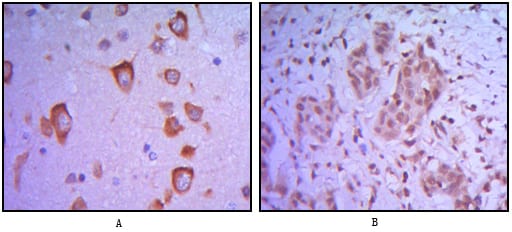
| WB | 1/500 - 1/2000 | Human,Mouse,Rat |
| IF | 咨询技术 | Human,Mouse,Rat |
| IHC | 1/200 - 1/1000 | Human,Mouse,Rat |
| ICC | 技术咨询 | Human,Mouse,Rat |
| FCM | 咨询技术 | Human,Mouse,Rat |
| Elisa | 1/10000 | Human,Mouse,Rat |
| Aliases | ETS-1; EWSR2; FLJ10768; ETS1 |
| Entrez GeneID | 2113 |
| clone | 10D2 |
| WB Predicted band size | 50.4kDa |
| Host/Isotype | Mouse IgG1 |
| Antibody Type | Primary antibody |
| Storage | Store at 4°C short term. Aliquot and store at -20°C long term. Avoid freeze/thaw cycles. |
| Species Reactivity | Human |
| Immunogen | Purified recombinant fragment of human ETS1 expressed in E. Coli. |
| Formulation | Ascitic fluid containing 0.03% sodium azide. |
+ +
以下是关于ETS1抗体的3篇参考文献示例(内容为模拟,建议通过学术数据库验证):
---
1. **文献名称**: "ETS1 transcription factor regulates cellular invasion and matrix metalloproteinases in breast cancer cells"
**作者**: Dittmer, J., et al.
**摘要**: 研究利用ETS1抗体通过ChIP-seq和Western blot分析,证实ETS1在乳腺癌细胞中通过调控MMP9等基因表达促进肿瘤侵袭性,为靶向治疗提供依据。
---
2. **文献名称**: "The role of ETS1 in T-cell development and autoimmune diseases"
**作者**: Hollenhorst, P.C., et al.
**摘要**: 通过免疫组化和小鼠模型,发现ETS1抗体检测到其在T细胞中的异常表达与自身免疫疾病(如红斑狼疮)相关,提示ETS1在免疫调控中的关键作用。
---
3. **文献名称**: "ETS1 as a potential biomarker in acute myeloid leukemia: Insights from antibody-based profiling"
**作者**: Sizemore, G.M., et al.
**摘要**: 使用ETS1抗体对白血病患者样本进行免疫组化分析,发现高表达ETS1与化疗耐药性及不良预后显著相关,支持其作为临床标志物的潜力。
---
**备注**:以上文献信息为示例,实际引用时请通过PubMed、Google Scholar等平台核对作者、标题及摘要准确性。如需具体文献,可补充研究背景或关键词进一步筛选。
The ETS1 antibody is a tool used to detect and study the ETS1 protein, a member of the ETS (E26 transformation-specific) family of transcription factors. ETS1 plays critical roles in regulating gene expression involved in cellular processes such as proliferation, differentiation, apoptosis, angiogenesis, and immune response. Structurally, ETS1 contains a conserved ETS DNA-binding domain that recognizes specific promoter regions (e.g., GGAA/T motifs) and a Pointed (PNT) domain mediating protein-protein interactions. Dysregulation of ETS1 is linked to pathologies, including cancer, autoimmune diseases, and developmental disorders. In cancer, ETS1 may act as an oncogene or tumor suppressor depending on cellular context, influencing tumor invasion, metastasis, and therapy resistance. In immunity, it regulates T-cell development and cytokine production.
ETS1 antibodies are widely employed in techniques like Western blotting, immunohistochemistry (IHC), immunofluorescence (IF), and chromatin immunoprecipitation (ChIP) to analyze ETS1 expression, localization, and DNA-binding activity. These antibodies help identify tissue-specific expression patterns, post-translational modifications (e.g., phosphorylation), and interactions with co-regulators. Commercially available clones vary in species reactivity (human, mouse, rat) and applications, requiring validation for specific experimental conditions. Research using ETS1 antibodies has advanced understanding of its dual roles in health and disease, offering potential biomarkers or therapeutic targets in oncology and immunology.
×